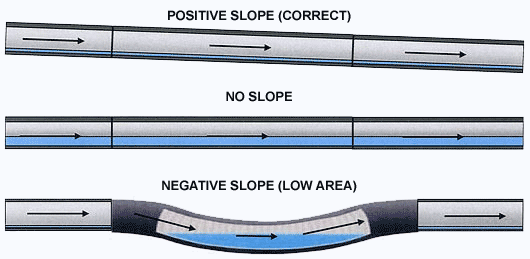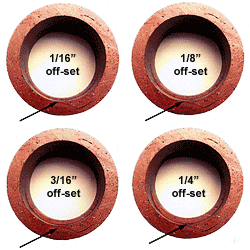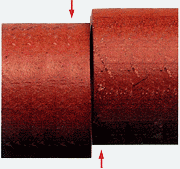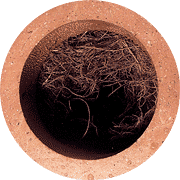Common Problems
Common Problems:
A "low area" (a.k.a. Sag or Belly) is where the sewer pipe has lost positive slope going to its destination, i.e. the city sewer main or in some cases a septic tank. With rare exception, sewers flow by gravity to where it ties onto the city's main sewer and becomes their responsibility. If a line is properly installed, it will have a positive slope for the entire duration of its distance.
Under normal conditions, sewers are installed with a fall of 1/4" per every one foot of length. Under difficult circumstances (and with the city inspector's OK) a bare minimum of 1/8" fall per foot is acceptable, although not preferred.
A low area can be identified by seeing the sewer continue to hold water after the flow has stopped. Problems begin when incoming water is flushed down the sewer line, and it hits a "blockage" of standing water. Severe low areas cause the water (along with the debris it is transporting) to lose speed and settle in the low area, eventually causing a clog.
Low areas can be caused by a number of factors, such as: shifting soil, poor soil compaction, poor installation, or a broken pipe (usually at a joint) which is settling. Unfortunately, the only way to correct a low area is to excavate the affected area and re-install the pipe at the proper grade. Since this corrective action is so extreme and often costly, it should only be corrected if it is truly causing an actual problem, not just "lacking perfection" for a short distance. For instance, a low area holding 1/2" of water for three or four feet is not "technically correct" per the plumbing code book. However, will this cause a problem? The answer is no.
The problem now becomes…how much of a low area is too much?
The best way to find out is to ask the owner if they have had problems in the past. If so, they may have documentation from prior plumbing service calls on the distance out that the clog was cleared. This information, in conjunction with a camera inspection, may help determine if the low area is excessive.
There are also other factors which come into play when considering if a repair is needed (i.e. the type of pipe used, water volume used, recent change in depth of low area, degree of tree root infiltration, corrosion build up, grease, etc.) These can all be contributing factors for the collecting of debris in a low area.
Keep in mind that in the best situation, sewers with a low area will need more attention than sewers without one. In addition, low areas may get lower over time until it makes sense to repair it. If we believe a slight low area(s) will not cause you an immediate problem, it may not even be mentioned on our report. It is always recommended by Hydro Physics® that you review your inspection results with a plumber of your choice to make the most informed decision possible based on your individual inspection.
Off-Set Pipe
Underground pipes are installed in sections or segments ranging from 2' to 20' or more. When connected sections do not line up perfectly with one another, they are referred to as being "off-set."
Sewer lines built from the 1800's up to the mid 1980's were constructed using a large number of short sections, typically 2' to 4' in length, of VCT (vitreous clay tile) pipe. These sewer lines are particularly subject to off-sets due to their large number of joints. During construction, the joints were sealed with products such as concrete, coal tar, oakum, rubber gaskets, and on occasion, nothing at all. Over time, these sealants erode away, allowing the pipe to then settle down into the "hub" of a connected pipe creating a slight offset. In most clay pipe, off-sets will not exceed 1/4" unless the pipe is broken at the hub. However, this only applied to pipes running in a straight line.
Most sewer camera systems will have a very difficult (if not impossible) time passing over a 1/4" off-set. If a sewer line is being video inspected and the technician passes over what he is calling a "severe off-set" and suggests excavation work is needed…beware. Compare his evaluation to those controlled models pictured here.
We recently did a re-inspection after a well known drain cleaning company "documented" four 1" off-sets with an accompanying $14,800 repair estimate. We found these off-sets to actually be 1/8", well within the acceptable range, and that no repair work was needed.
Tree Roots
Underground pipes are installed in sections or segments ranging from 2' to 20' or more. When connected sections do not line up perfectly with one another, they are referred to as being "off-set."
Sewer lines built from the 1800's up to the mid 1980's were constructed using a large number of short sections, typically 2' to 4' in length, of VCT (vitreous clay tile) pipe. These sewer lines are particularly subject to off-sets due to their large number of joints. During construction, the joints were sealed with products such as concrete, coal tar, oakum, rubber gaskets, and on occasion, nothing at all. Over time, these sealants erode away, allowing the pipe to then settle down into the "hub" of a connected pipe creating a slight offset. In most clay pipe, off-sets will not exceed 1/4" unless the pipe is broken at the hub. However, this only applied to pipes running in a straight line.
Most sewer camera systems will have a very difficult (if not impossible) time passing over a 1/4" off-set. If a sewer line is being video inspected and the technician passes over what he is calling a "severe off-set" and suggests excavation work is needed…beware. Compare his evaluation to those controlled models pictured here.
We recently did a re-inspection after a well known drain cleaning company "documented" four 1" off-sets with an accompanying $14,800 repair estimate. We found these off-sets to actually be 1/8", well within the acceptable range, and that no repair work was needed.
“We're up-front about what's down-under!”
Navigation links
Contact Us
Thank you for contacting Hydro Physics!
We will get back to you as soon as possible.
Please try again later.





